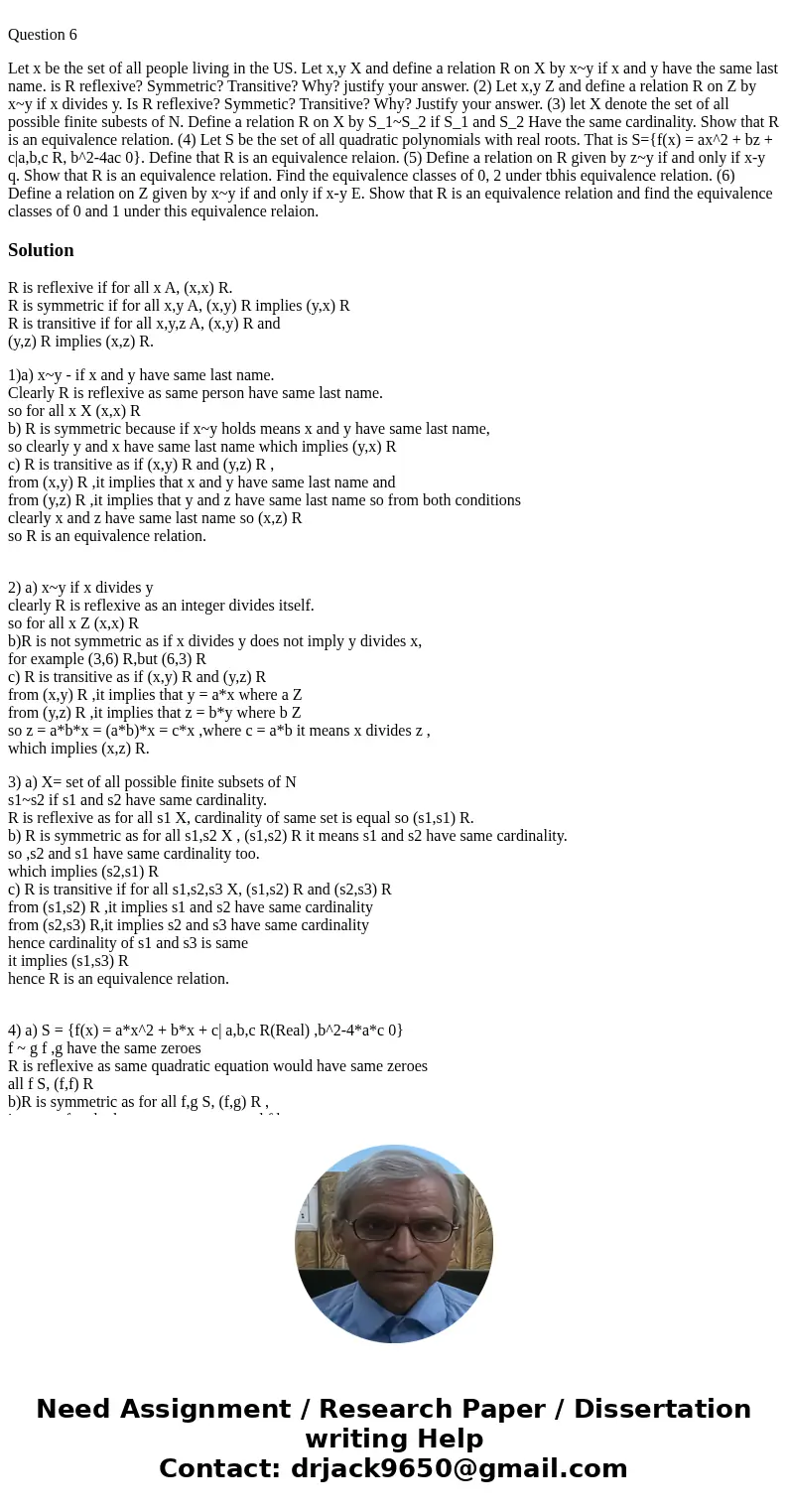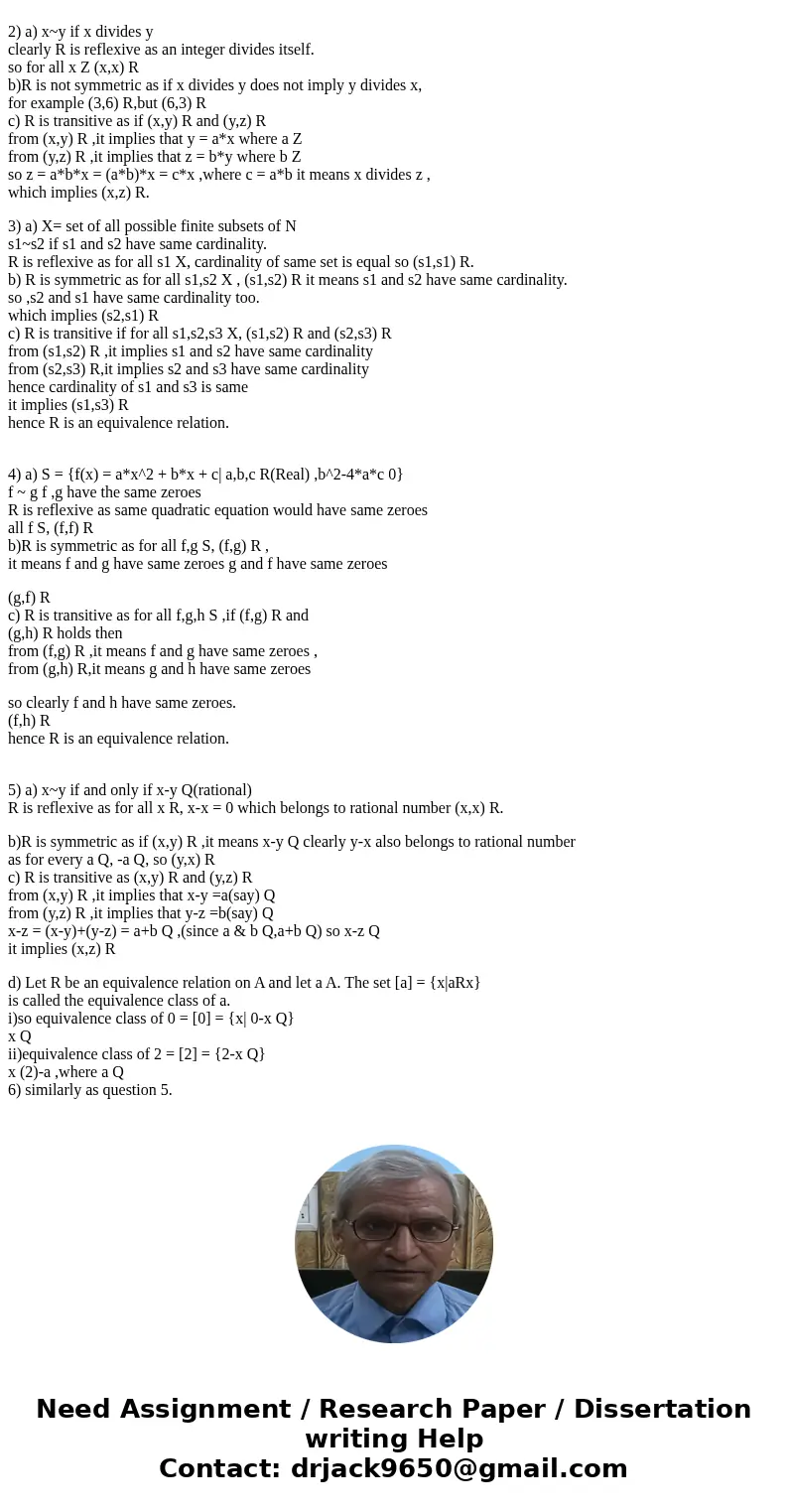Question 6 Let x be the set of all people living in the US L
Question 6
Solution
R is reflexive if for all x A, (x,x) R.
R is symmetric if for all x,y A, (x,y) R implies (y,x) R
R is transitive if for all x,y,z A, (x,y) R and
(y,z) R implies (x,z) R.
1)a) x~y - if x and y have same last name.
Clearly R is reflexive as same person have same last name.
so for all x X (x,x) R
b) R is symmetric because if x~y holds means x and y have same last name,
so clearly y and x have same last name which implies (y,x) R
c) R is transitive as if (x,y) R and (y,z) R ,
from (x,y) R ,it implies that x and y have same last name and
from (y,z) R ,it implies that y and z have same last name so from both conditions
clearly x and z have same last name so (x,z) R
so R is an equivalence relation.
2) a) x~y if x divides y
clearly R is reflexive as an integer divides itself.
so for all x Z (x,x) R
b)R is not symmetric as if x divides y does not imply y divides x,
for example (3,6) R,but (6,3) R
c) R is transitive as if (x,y) R and (y,z) R
from (x,y) R ,it implies that y = a*x where a Z
from (y,z) R ,it implies that z = b*y where b Z
so z = a*b*x = (a*b)*x = c*x ,where c = a*b it means x divides z ,
which implies (x,z) R.
3) a) X= set of all possible finite subsets of N
s1~s2 if s1 and s2 have same cardinality.
R is reflexive as for all s1 X, cardinality of same set is equal so (s1,s1) R.
b) R is symmetric as for all s1,s2 X , (s1,s2) R it means s1 and s2 have same cardinality.
so ,s2 and s1 have same cardinality too.
which implies (s2,s1) R
c) R is transitive if for all s1,s2,s3 X, (s1,s2) R and (s2,s3) R
from (s1,s2) R ,it implies s1 and s2 have same cardinality
from (s2,s3) R,it implies s2 and s3 have same cardinality
hence cardinality of s1 and s3 is same
it implies (s1,s3) R
hence R is an equivalence relation.
4) a) S = {f(x) = a*x^2 + b*x + c| a,b,c R(Real) ,b^2-4*a*c 0}
f ~ g f ,g have the same zeroes
R is reflexive as same quadratic equation would have same zeroes
all f S, (f,f) R
b)R is symmetric as for all f,g S, (f,g) R ,
it means f and g have same zeroes g and f have same zeroes
(g,f) R
c) R is transitive as for all f,g,h S ,if (f,g) R and
(g,h) R holds then
from (f,g) R ,it means f and g have same zeroes ,
from (g,h) R,it means g and h have same zeroes
so clearly f and h have same zeroes.
(f,h) R
hence R is an equivalence relation.
5) a) x~y if and only if x-y Q(rational)
R is reflexive as for all x R, x-x = 0 which belongs to rational number (x,x) R.
b)R is symmetric as if (x,y) R ,it means x-y Q clearly y-x also belongs to rational number
as for every a Q, -a Q, so (y,x) R
c) R is transitive as (x,y) R and (y,z) R
from (x,y) R ,it implies that x-y =a(say) Q
from (y,z) R ,it implies that y-z =b(say) Q
x-z = (x-y)+(y-z) = a+b Q ,(since a & b Q,a+b Q) so x-z Q
it implies (x,z) R
d) Let R be an equivalence relation on A and let a A. The set [a] = {x|aRx}
is called the equivalence class of a.
i)so equivalence class of 0 = [0] = {x| 0-x Q}
x Q
ii)equivalence class of 2 = [2] = {2-x Q}
x (2)-a ,where a Q
6) similarly as question 5.


 Homework Sourse
Homework Sourse